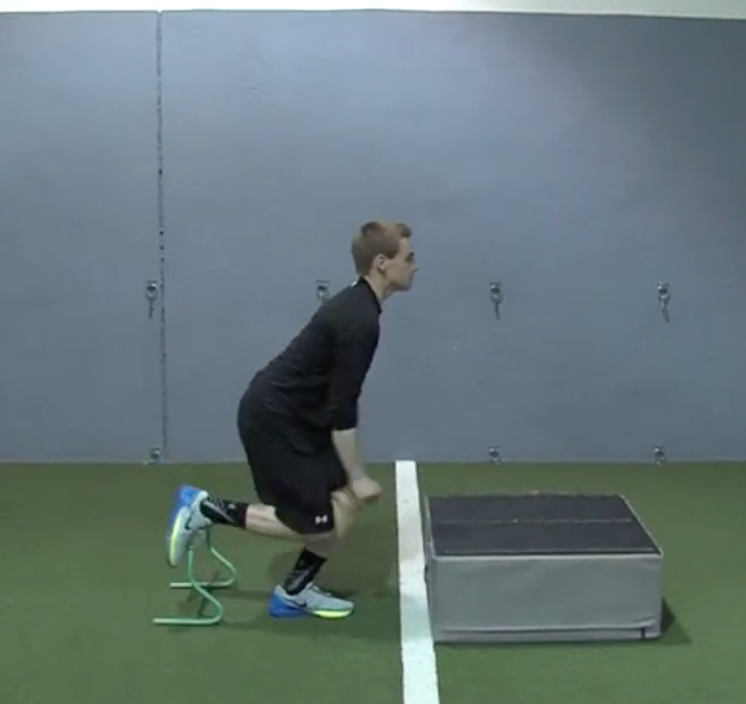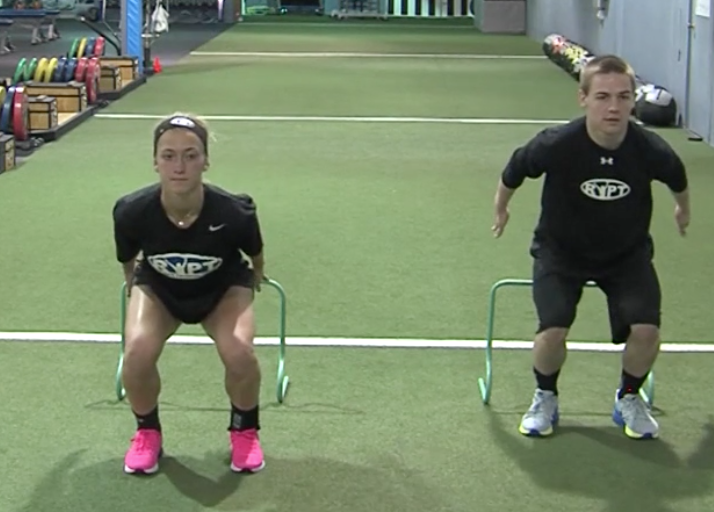Should Sprinting and Jumping Athletes Use Plyometrics?
By Keats Snideman, CSCS, LMT

What Are Plyometrics?
Probably one of the most commonly used (and abused) methods of performance-enhancement for sprinters and indeed all running and jumping athletes is “plyometrics.” Plyometrics can be defined as movements that involve fast eccentric muscle actions followed by dynamic and explosive concentric actions (aka, the stretch-shortening cycle). The best example of a plyometric drill that comes to mind is the classic “depth jump” exercise where an athlete drops off a box or step of some pre-determined height. Upon hitting the floor the athlete concentrates on explosively jumping into the air as high as possible.
The purpose of this method is to “shock” the body and nervous system to produce higher levels of muscle tension and force than would normally be possible without the preceding drop. In fact, the “father” and creator of modern day plyometrics, Yuri Verkoshansky of Russia, originally named the plyometric method the “shock” method. To understand how such a system of exercises could be beneficial or detrimental to sprinting, jumping, and indeed all athletes, let’s take a closer look at basic muscle function during movement.
Reversible Muscle Action (i.e. The Stretch-Shortening-Cycle)
Through scientific observation, it has been discovered that if a muscle is stretched immediately before a shortening (concentric) muscle action, force and power output will be increased and energy expenditure will be less. To demonstrate this phenomenon, assuming you are sitting while reading this article, try to stand up. Do it now. Could you feel your body rock back to stretch the thigh muscles a little before you stood up? This is perfectly natural and is called “pre-stretch.” Many sporting actions and resistance training exercises actually involve some level of pre-stretch which enhance the subsequent performance. In the case of sprinters, have you ever noticed the different rituals they use when getting in the blocks. Often, you’ll see the sprinters stretching and kicking their legs behind the blocks before setting their feet in them. This is pre-stretch at work. Now getting back to our little sit-to-stand movement again, I want you to try standing without any pre-stretch (rocking back) whatsoever. In other words, lean forward a little from the hips and then stay still for a few seconds before trying to rise. Much harder if not impossible isn’t it? This simple test and observation is an easy example of how natural it is for human movements to utilize eccentric/lengthening muscle actions prior to concentric/shortening actions.
Even human gait (walking) utilizes this stretch-shortening-cycle to make it more efficient in terms of energy expenditure. In fact, if you walk at a comfortable walking speed (you’re preferred speed), you should be able to walk practically forever. However, if walking speed is increased or decreased from this preferred cadence, efficiency is lost and perceived effort may increase. Let’s apply this pre-stretch stuff now to running, sprinting and jumping. In sprinting in particular, there is a greater stretch of the plantar flexor muscles (gastroc-soleus, etc…) if the foot and ankle are pulled up (i.e. into “dorsiflexion”) prior to foot strike (heel strike in walking and running). If performed correctly, this pre-stretch is followed by and explosive isometric muscle action and then the propulsive concentric action which moves the body forward and upward off the ground.
This is also what happens during a vertical jump except that the arms and shoulders might be used more or less aggressively depending on the situation. This entire process is due to stored elastic energy in the muscles and tendons (think of a spring) and neurological reflexes (primarily the myotatic stretch reflex). When combined with a volitional effort to explode, improved performance (i.e. fasting sprinting times, higher vertical jumps, etc…) can be realized.

Classification Of Plyometric Exercises
Plyometrics can be broken down into various types for simplicity. First off, you have “Impact” and “Non-Impact” forms of plyometrics. With impact plyos you have direct contact with a surface (i.e the ground or playing surface) or an object (such as a medicine ball or sporting implement). In contrast, non-impact plyos involve a quick stretch (recoil) of one or several body parts and joints which then culminate in an explosive concentric muscle action. Examples of non-impact plyometric actions include various kicks and punches in martial arts and boxing. Also, you can think of a baseball pitch as a very dynamic and explosive non-impact plyometric movement. Ever seen a slow-motion or still picture of a pitcher’s arm in the cocked back position (extreme external rotation)? Now that’s some pre-stretch!
Next, plyometrics can be classified according to their intensity level. Similar to strength training exercises, you can have high-intensity plyos like depth jumps and plyometric push-ups and low-intensity variations such as skips, hops, jumping rope and jumps onto boxes for example. The intensity of plyos should really be thought of as a continuum rather than belonging to distinct categories. For instance, one athlete may find jumping rope extremely difficult and challenging whereas another athlete may find the same activity trivial, merely a warm-up. In general, it really depends on the fitness level of the athlete when it comes to choosing specific plyometric exercises. This will be discussed later in the article.
Next, you have preparatory and supplementary plyometrics which help prepare the body to hand the stress and force of fast eccentric muscle actions. This would include the lower intensity plyos discussed above such as skipping, hops, agility ladder drills, rope jumping, jumps onto boxes (but not off) and most forms of free-weight strength training. All these help to prepare the body to handle and produce more force while developing and strengthening the connective tissues.
As an interesting side note, some sport scientists such as the late Dr. Mel Siff, state that in order for an exercise to be classified as truly plyometric, the time interval between the eccentric-isometric (force absorption) phase and the subsequent concentric (force creation) phase must be short, as little as 0.15 seconds in lower extremity plyometric activities. Any longer than this and the movement is considered regular “jump” training, but not plyometrics. But this isn’t set in stone as other research has shown that some benefit still occurs in upper body muscle groups for up to four seconds after an eccentric muscle action (Wilson, et. al).
To recap, the basic premise and theory of plyometrics (and all training in general) to remember is as follows: if you can train the muscles, tendons, and nervous system to produce more force/tension in a shorter period of time during the takeoff from the ground, you can improve performance. This is primarily what the goal is with specific plyometric training. Sounds good right?
Plyometrics And Anaerobic-Dominant Sports
When you look at Track & Field (sprints, hurdles, jumps and throws) and most sports that rely heavily on anaerobic energy processes (i.e. Baseball, Volleyball, Basketball, Tennis, Football, etc…), you realize that there is already a relatively high amount of sprinting and jumping occurring anyway. It’s hard to deny that plyometric muscle action is a vitally important part of performance in these activities, but care must be taken when prescribing and performing specific plyometric movements to avoid overloading vulnerable and overworked areas such as the Achilles tendons, knees, and the lower back. If the plyometric exercises are being applied to the upper body (i.e. plyometric push-ups, medicine ball rebounds, etc…) problems can develop in the wrist, elbow, and shoulder areas. Usually, most of the injuries that occur are due to over-zealous use of and the misapplication of plyometric exercises and related drills. As with any training method, if problems arise, it usually the application of and not the method itself that is to blame. If plyometrics are to be used safely, a carefully planned integration must take place. Next, we will look at a rational plyometric progression process.
A Rational Progression of Plyometrics
The first step after making the decision to include specific plyometric exercises in an athlete’s program is to consider the nature of the sport and the current stress/strain being applied to the body from the sport itself. As mentioned above, sports such as Basketball. Volleyball and jumps/sprints from Track & Field already contain a high volume of plyometric muscle actions. For many of these participants, especially younger and novice-level ones, time might be better spent by focusing on getting stronger (improving maximal strength) through a progressive resistance training program and just playing the sport itself. True impact plyometrics (as discussed earlier) don’t need to be explored until the athlete is sufficiently strong and has developed a good foundation of connective tissue, joint, bone, muscle, and tendon integrity. This does not mean that preparatory and supplementary plyometrics should not be performed because they can help to prepare the body for more demanding plyometric exercises in the future.
A great place to start is to ensure adequate levels of basic strength are in order. Variations of the following strength and power lifts are a great place to start:
1. Squatting (especially front and back squats because they basically simulate the natural jumping movement pattern)
2. Deadlifts (including RDL’s, snatch-grip, clean-grip, sumo and conventional style)
3. Olympic lift variations (For a GREAT resource, see Complete Olympic Lifting)
4. Pressing (both bench press and military press variations)
5. Rows/Chins (for postural support, upper back and elbow flexor development)
6. Supplementary/Assistance Strength Movements (such as single leg exercises, reverse and regular back hypers, GHR, planks, Swiss-ball exercises, medicine ball abdominal movements, woochops, etc…)
The key with athletes is to keep it simple in the weight room and realize that we’re trying to create athletes, not bodybuilders. Keep the primary lifts in the strength and power building rep range (1-5 reps, maybe as high as 8) and leave the higher reps for the supplementary/assistance lifts (10-15 reps is quite common for these exercises).
Depending on the specific athlete’s fitness levels and training history, some preparatory and introductory plyos can be started usually from day one. In addition to basic skipping and sprinting drills, some great beginning drills include the following:
1. Two Foot Hops/Jumps In Place– these are very mild and done insets of 20-25 repetitions. Maximal height on these is NOT the goal here. Simply strive for a comfortable frequency that permits a fluid and rhythmic series of small jumps in place.
2. Jumping Rope– done at a faster pace, jumping rope is a fantastic preparatory drill that teaches an athlete a lot about timing, rhythm and helps to develop basic coordination. As with all plyometrics, the key is to keep the ground contact brief between jumps. Start with as little as 15-30 seconds and build up to 60 seconds worth of jumping. Any more than a minute of continuous jumping is not ideal since it takes the athlete further away from the anaerobic energy systems they are trying to improve (ATP-CP & Anaerobic Glycolysis). If you want to make it harder, simply make the jumps more complicated by adding in side-to-side, front-to-back, high knees (running man), Ali-shuffles, double jumps (2 revolutions per jump) and rope crossing. The variations are almost endless!
3. Agility Ladder Drills– similar to jump roping, the variations are endless. Simply focus on short ground-contact times and fluidity of movement. Keeping the eyes up and not on the ground adds to the difficulty. After a period of adaptation to the above mentioned drills, higher intensity drills can start to be introduced:
4. Jumps onto Boxes– just as the name says, perform individual jumps onto boxes while sticking the landing with ideal body mechanics. This means a nice “athletic” position with knees lined up in the direction of the toes (no excessive inward or outward bowing of the knees)! As the athlete improves, jump height increases. Sets of 5 reps or so should be performed for only a few sets. Ensure the athlete steps off (not jumps off) the box in preparation for each successive rep.
5. Depth (Altitude or Drop) Jumps– in this variation, the athlete simply steps off the box and then “sticks” the landing in the ideal athletic position as mentioned above. It’s important to strive for a quiet landing as this ensures that the force is being dissipated properly upon foot contact with the floor. As famous Strength Coach Michael Boyle likes to say, “if it doesn’t look right, it isn’t.” Always start with a low box and only progress when form is near perfect.
6. Depth Jumps– not all athletes need to progress to this level of training but if they are to be done, they must be done right. The set-up is very similar to the Depth Drops as discussed earlier; the only difference here is that the athlete will explosively rebound off the floor upon hitting it, as if the surface was red hot. Since depth jumps are very ballistic movements, there must be some planning in advance (in the athlete’s mind), a process known in motor control as a “feed-forward” type of control. All ballistic actions utilize this feed-forward type of planning because there is not enough time to use “feedback” as with slower more predictable type of movements and activities. This is what differentiates true plyometric movements from the more commonly performed “pseudoplyometric” movements. The reps and sets on depth jumps are similar to depth drops but include greater rest periods (3 to 5 minutes for maximum height depth jumps). Remember, these movements are HIGHLY stimulating to the nervous system! And since the nervous system take longer to recover than the cellular/metabolic system, you must take this into account if you are to maximize the potential benefits, and minimize the risks.
Conclusion
There is so much more that could be said regarding plyometrics and athletes, but hopefully I’ve hit the major points that need to be taken into account when designing athletic enhancement programs. I truly believe that many sprinting and jumping athlete can get phenomenal results without EVER doing any super high-intensity plyos. Getting stronger and more explosive in the gym can go a long way to improving game speed as long as some speed work is continued at least most of the year. If true plyos are to be used, than at least do a little homework to ensure a safe and proper progression for your athletes so performance can be maximized with less risk of injury.
Recommended Athletes' Acceleration Products
ABOUT THE AUTHOR
 Keats Snideman is a Certified Strength & Conditioning Specialist (CSCS) and a licensed massage therapist specializing in Neuromuscular Therapy (NMT). Based out of the Phoenix (AZ) Metro area, Keats specializes in the enhancement of athletic-style fitness and has a proven track record for getting his clients results. He has coached and provided treatment to a variety of clients (athletic and non-athletic alike). Some of the clients Keats has worked with include athletes from the NFL, NBA, MLBA, USA Track & Field as well as athletes from both the collegiate and high school levels. He is currently the recovery and regeneration consultant for World’s Strongest Man Competitor Kevin Nee. For recreation and fun, Keats also competes as a competitive sub-masters sprinter (100 & 200m dashes). He may be reached through his website at:www.coachkeats.com.
Keats Snideman is a Certified Strength & Conditioning Specialist (CSCS) and a licensed massage therapist specializing in Neuromuscular Therapy (NMT). Based out of the Phoenix (AZ) Metro area, Keats specializes in the enhancement of athletic-style fitness and has a proven track record for getting his clients results. He has coached and provided treatment to a variety of clients (athletic and non-athletic alike). Some of the clients Keats has worked with include athletes from the NFL, NBA, MLBA, USA Track & Field as well as athletes from both the collegiate and high school levels. He is currently the recovery and regeneration consultant for World’s Strongest Man Competitor Kevin Nee. For recreation and fun, Keats also competes as a competitive sub-masters sprinter (100 & 200m dashes). He may be reached through his website at:www.coachkeats.com.
—————————————————————————–




0 Comments for “Should Sprinting and Jumping Athletes Use Plyometrics?”